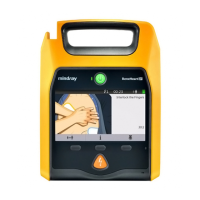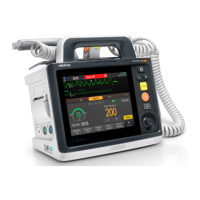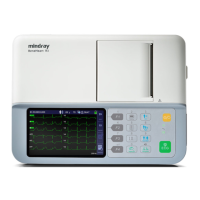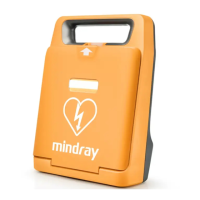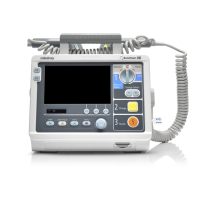
Do you have a question about the Mindray BeneHeart D3 and is the answer not in the manual?
| Type | Defibrillator |
|---|---|
| Display | Color TFT LCD |
| Display Size | 5.7 inches |
| Waveform | Biphasic Truncated Exponential (BTE) |
| Heart Rate Range | 15-300 bpm |
| SpO2 Range | 0-100% |
| NIBP Measurement Method | Oscillometric |
| Printer Type | Thermal |
| Paper Width | 50 mm |
| Paper Speed | 25 mm/s |
| IP Rating | IP44 |
| Modes | Manual, AED, Pacing |
| AED Mode Energy Sequence | 150J, 200J |
| Charging Time | <5 seconds to 200J |
| Battery Type | Lithium-ion |
| ECG Monitoring | 3-lead |
| Energy Selection | 1-360 J (Manual Mode) |
Details specific conditions not covered by the warranty.
Explains the manual's goal and importance for safe operation.
Specifies the target users for this operator's manual.
Explains formatting and symbols used within the manual for clarity.
Provides critical safety information including dangers, warnings, and cautions.
Explains common symbols used on the equipment and in the manual.
Introduces the device, its modes of operation, and key features.
Details the specific applications and target users for the defibrillator/monitor.
Lists the components and accessories that are in contact with the patient.
Describes the physical layout and components of the main unit.
Details the function and components of the external paddles used with the device.
Illustrates typical screen layouts and explains the information displayed in different modes.
Outlines the necessary steps and precautions for installing the equipment.
Covers fundamental operational procedures like connecting power and turning on.
Explains how to adjust system-wide settings like date, time, and volume.
Classifies alarms into physiological, technical, and prompt messages.
Defines the severity levels of alarms and their corresponding indicators.
Details the visual and audible signals used to indicate alarms.
Explains how to adjust alarm volumes and reminder tones.
Guides users on configuring and managing alarm properties.
Describes how to temporarily disable alarms.
Explains the conditions and methods for turning alarms off.
Details how to disable audible alarm tones.
Explains how to reset active alarms.
Describes how alarm indicators behave when conditions persist.
Explains how technical alarms are cleared and their behavior.
Guides on how to test the functionality of the alarm system.
Provides steps to follow when any alarm condition is detected.
Introduces the ECG monitoring function and its capabilities.
Provides critical safety precautions related to ECG monitoring.
Describes the typical ECG monitoring screen layout.
Details skin preparation and electrode placement for accurate ECG readings.
Shows a typical ECG display in 3-lead mode.
Explains how to customize ECG display and analysis settings.
Covers the analysis of heart rhythms and related alarms.
Details the process for calibrating the ECG signal amplitude.
Offers solutions for common problems encountered during ECG monitoring.
Introduces the Automated External Defibrillator (AED) mode.
Provides critical safety precautions for operating in AED mode.
Illustrates the typical AED mode screen layout.
Outlines the step-by-step procedure for using the AED function.
Explains the system's response when a shockable rhythm is detected.
Describes the system's response when a non-shockable rhythm is detected.
Covers CPR-related functions and features within the AED mode.
Explains how to enable and use the AED sound recording feature.
Guides on configuring various AED operational settings.
Introduces manual defibrillation and cardioversion procedures.
Provides crucial safety precautions for manual defibrillation.
Shows a typical screen display for manual defibrillation mode.
Details the steps for performing manual defibrillation and cardioversion.
Explains how to perform synchronized cardioversion.
Describes how to perform synchronized cardioversion remotely.
Details the contact impedance indicator and its role in defibrillation.
Introduces the CPR feedback feature when using a CPR sensor.
Covers how to use the CPR sensor for feedback and data management.
Introduces the noninvasive pacing function and its operation.
Provides critical safety precautions for noninvasive pacing.
Illustrates the typical screen display for pacing mode.
Explains the demand and fixed modes of pacing.
Details the preparation steps required before initiating pacing.
Introduces the respiration monitoring function and its measurement technique.
Provides critical safety precautions for respiration monitoring.
Shows the typical respiration monitoring display.
Details the correct placement of electrodes for respiration monitoring.
Offers solutions for common problems in respiration monitoring.
Introduces pulse rate monitoring and its source.
Explains how to adjust the volume of the pulse tone.
Introduces SpO2 monitoring and its measurement technique.
Helps identify different types of SpO2 modules used with the equipment.
Provides critical safety precautions for SpO2 monitoring.
Lists factors that may affect the accuracy of SpO2 measurements.
Shows the typical SpO2 monitoring display.
Details the steps for performing SpO2 monitoring.
Explains how to adjust various SpO2 monitoring settings.
Describes the specific SpO2 desaturation alarm.
Explains the pitch tone feature that varies with SpO2 levels.
Offers solutions for common problems in SpO2 monitoring.
Introduces non-invasive blood pressure monitoring using the oscillometric method.
Provides critical safety precautions for NIBP measurements.
Lists situations where NIBP measurement may be inaccurate or impossible.
Explains the different modes for NIBP measurement: Manual, Auto, STAT.
Shows the typical numeric display for NIBP measurements.
Details the steps for preparing and performing NIBP measurements.
Explains how to manually set the initial cuff inflation pressure.
Describes how to change the unit for NIBP pressure measurement.
Offers solutions for common problems in NIBP monitoring.
Introduces CO2 monitoring and its infrared light absorption technique.
Provides critical safety precautions for CO2 monitoring.
Lists factors that may affect the accuracy of CO2 measurements.
Shows the typical display for CO2 measurement parameters and waveform.
Details the steps for preparing and connecting the CO2 module.
Explains how to adjust various CO2 monitoring settings.
Advises on safely removing exhaust gases, especially with anesthetics.
Mentions CO2 calibration procedures performed by qualified personnel.
Offers solutions for common problems in CO2 monitoring.
Explains how to mark significant events during patient monitoring or therapy.
Details how to review recorded patient events.
Explains how to view recorded data in tabular trend format.
Guides on reviewing CPR events when a CPR sensor is used.
Provides an overview of the data management functions available.
Explains how patient data archives are automatically generated.
Details how to edit previously stored patient information.
Guides on how to review recorded patient events from archives.
Explains how to export patient data to USB memory.
Introduces the thermal recorder and its functions.
Lists the different types of recordings the equipment can perform.
Explains manual and automatic methods for starting recordings.
Details manual and automatic methods for stopping recordings.
Covers configuration options for the recorder, like waveforms and speed.
Provides instructions on how to load paper into the recorder.
Guides on how to clear paper jams from the recorder.
Explains how to clean the recorder's print head for optimal performance.
Introduces the network capabilities for data transmission.
Covers basic network configuration like type, DNS, and preset sites.
Explains how to connect the equipment to a Central Monitoring System (CMS).
Details the process of connecting to an HL7 server for data transmission.
Introduces the system's ability to customize equipment settings.
Explains how to change the password for accessing configuration settings.
Guides on how to view the current system configurations.
Details how to export current configurations to a USB flash memory.
Explains how to import configurations from one equipment to another.
Covers modifying settings within various setup menus or restoring defaults.
Introduces the internal battery system and its charge status indicators.
Provides critical safety precautions related to battery usage and charging.
Details the procedure for installing and replacing the battery.
Explains the different types of battery alarms and their meanings.
Describes the process for conditioning the battery to extend its service life.
Guides on how to check the battery's performance and expected life.
Explains how the battery is charged when connected to power.
Provides guidelines for storing batteries properly.
Advises on the proper disposal and recycling of used batteries.
Provides general rules for keeping the equipment and accessories clean.
Details the recommended cleaning agents and procedures for the equipment.
Explains the importance and process of disinfecting the equipment.
Notes that sterilization is generally not recommended for this equipment.
Emphasizes the importance of regular maintenance for equipment readiness.
Provides critical safety precautions related to maintenance procedures.
Outlines periodic maintenance tasks and recommended test items.
Describes specific function checks to ensure equipment readiness.
Details annual preventive maintenance procedures.
Lists available ECG accessories, including electrodes and cables.
Lists available SpO2 accessories like extension cables and sensors.
Lists available NIBP accessories, including hoses and cuffs.
Lists available accessories for CO2 monitoring.
Lists accessories related to defibrillation and pacing therapy.
Lists various other accessories and components for the equipment.
Provides general safety, physical, display, and audio specifications.
Details specific technical specifications for the defibrillator function.
Lists specifications related to CPR compression measurements.
Provides technical specifications for the pacing function.
Details specifications for various monitoring functions like ECG, SpO2, NIBP, etc.
Lists specifications for AC power and battery operation.
Provides technical specifications for the built-in recorder.
Details alarm levels, categories, and settings.
Specifies the data storage capacity for events, waveforms, and patient archives.
Lists the technical specifications for the Wi-Fi wireless communication.
Outlines the operating and storage environmental conditions for the equipment.
Describes the methods and criteria used for rhythm analysis.
Lists the databases used for validating the algorithm's performance.
Defines the categories of heart rhythms analyzed by the algorithm.
Presents test results on the algorithm's performance against standards.
Covers electromagnetic compatibility requirements and guidelines.
States compliance with radio regulatory directives and warnings.
Lists and explains physiological alarms, their levels, causes, and solutions.
Lists and explains technical alarms, their levels, causes, and solutions.
Details safety checks for the power cord plug and its components.
Covers visual and contextual inspection of the device's exterior.
Ensures that all device labels are present and legible.
Describes the test for protective earth resistance and its limits.
Explains the procedure and limits for earth leakage testing.
Details the measurement of patient leakage current under various conditions.
Covers testing for mains voltage leakage on applied parts.
Describes the measurement of patient auxiliary current.
Lists common units of measurement used in the manual.
Explains common mathematical and logical symbols.
Provides a glossary of abbreviations and acronyms used in the manual.

